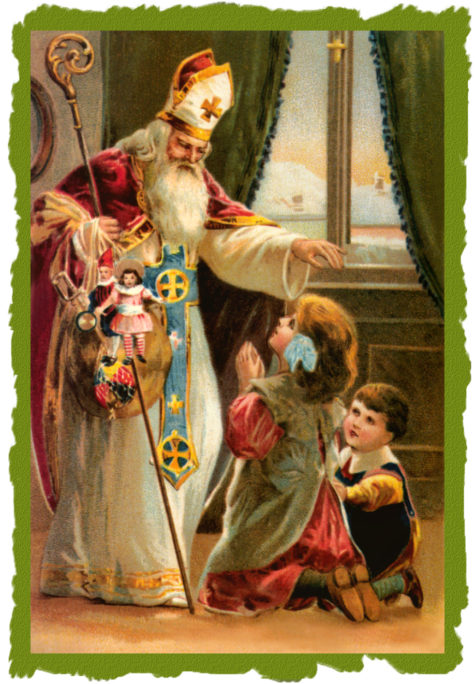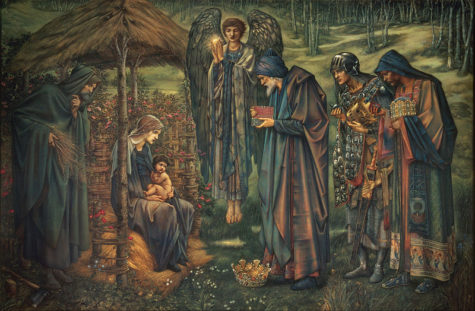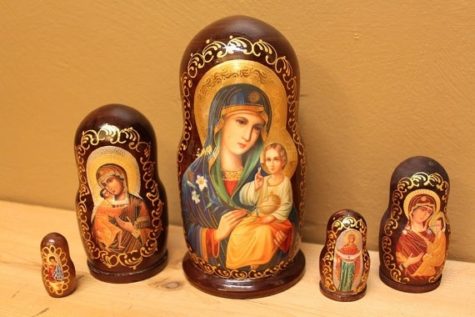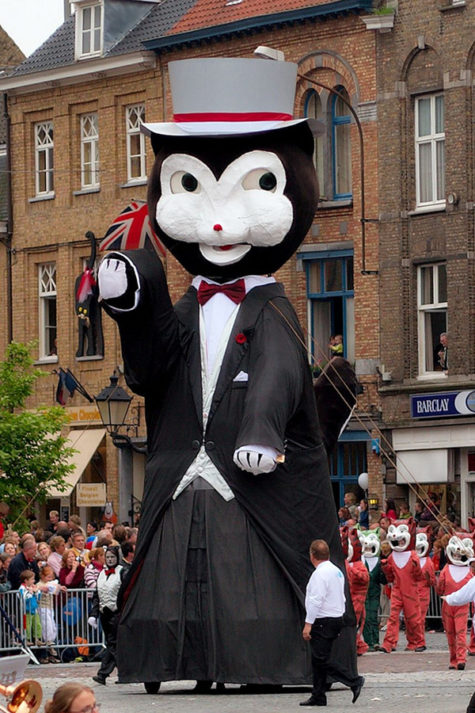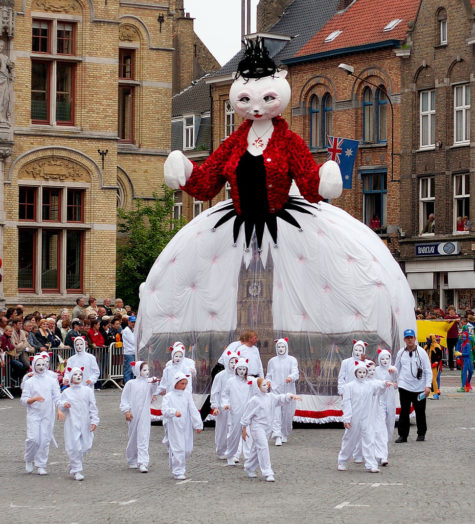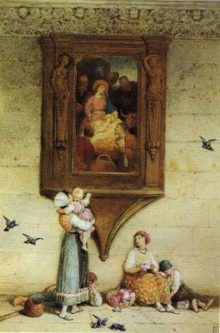 December 28 is Dyzymas Day, also known as Holy Innocent’s Day, or Childremass. This day has always, in one way or another been associated with children. In more recent times the connection is specifically with the children slaughtered at the orders of Herod, who feared the prophecy of the Magi that a new King of the Jews had been born in Judea.
December 28 is Dyzymas Day, also known as Holy Innocent’s Day, or Childremass. This day has always, in one way or another been associated with children. In more recent times the connection is specifically with the children slaughtered at the orders of Herod, who feared the prophecy of the Magi that a new King of the Jews had been born in Judea.
Throughout the Middle Ages this day was considered particularly unlucky and it was believed that no task begun on December 28th would prosper. Both the French King Louis XI and the English King Edward IV refused to do any business on this date, and the latter postponed his coronation when it was originally planned for this inauspicious date.
In Northamptonshire it was known as Dyzymas Day and a local saying was:
“What is begun on Dyzymas Day will never be finished.”
A more barbaric practice that continued well into the eighteenth century was to beat children on this day. This seems to have been a curious mixture of ideas – that if the children were made to suffer on this day they would be spared the rest of the year, and, moreover, that such beatings would drive out any evil spirits who might have taken up residence in the child.
These beatings rarely involved real cruelty. Indeed, the underlying theme of the day was a kind of equality. Thus wives and husbands exchanged token blows, and in parts of Germany and Sweden children were permitted to beat their parents.
Freshly gathered evergreen branches were used for this task, with birch and rosemary being particularly popular. A chant preserved from this time goes:
Fresh green! Long life!
Give me a coin!
While in other places servants beat their masters crying:
Fresh, green, fair, and fine,
Gingerbread and brandy-wine!
The whole idea seems to have been to show that by expressing individuality and exchanging gentle blows, true anger and aggression might thus be waived for the coming year – an enlightened notion from which we might well learn today.
From The Winter Solstice
Many countries in Europe celebrate the Feast of Sinterklaas, or St. Nicholas, on the eve of December 6. After dinner, families hunt for their presents, following clues in funny, anonymous poems. They also eat candies and cookies, especially spicy crispy ginger-cookie figures formed in a traditional wooden mold.
The legend of St. Nicholas is, like the lives of many saints, shrouded in mystery. We know that he was the bishop of Myra in Lycia, part of Asia Minor, during the fourth century. He is credited with saving three sisters from lives of ill repute by throwing bags of gold into their house (some say down the chimney, others say through the window) to provide for their dowries.
In many places in the United States and abroad, children still hang their stockings by the chimney or place their shoes by the window for St. Nicholas to fill them with presents and sweets on the eve of his feast day. He is considered the patron saint of children.
Source: Almanac.com
Advent is a season observed in many Western Christian churches as a time of expectant waiting and preparation for the celebration of the Nativity of Jesus at Christmas. The term is a version of the Latin word meaning “coming”.
It is unknown when the period of preparation for Christmas that is now called Advent first began – it was certainly in existence from about 480 – and the novelty introduced by the Council of Tours of 567 was to order monks to fast every day in the month of December until Christmas. Some have even said it goes back to the time of the Twelve Apostles or that it was founded by Saint Peter himself. This has led to the conclusion that it is “impossible to claim with confidence a credible explanation of the origin of Advent”.
For Christians, the season of Advent anticipates the coming of Christ from three different perspectives. “Since the time of Bernard of Clairvaux (d.1153) Christians have spoken of the three comings of Christ: in the flesh in Bethlehem, in our hearts daily, and in glory at the end of time.” The season offers the opportunity to share in the ancient longing for the coming of the Messiah, and to be alert for his Second Coming.
Advent is the beginning of the Western liturgical year and commences on the fourth Sunday before Christmas, the Sunday nearest to St. Andrew’s Day (30 November), in the Roman Rite of the Catholic Church, and in the Anglican, Lutheran, Moravian, Presbyterian and Methodist calendars. In the Ambrosian Rite and the Mozarabic Rite of the Catholic Church, Advent begins on the sixth Sunday before Christmas, the Sunday after St. Martin’s Day (Nov 11).
Practices associated with Advent include keeping an Advent calendar, lighting an Advent wreath, praying an Advent daily devotional, as well as other ways of preparing for Christmas, such as setting up Christmas decorations, a custom that is sometimes done liturgically, through a hanging of the greens ceremony.
The equivalent of Advent in Eastern Christianity is called the Nativity Fast, but it differs in length and observances, and does not begin the liturgical church year as it does in the West. The Eastern Nativity Fast does not use the equivalent parousia in its preparatory services.
Folk traditions:
In England, especially in the northern counties, there was a custom (now extinct) for poor women to carry around the “Advent Images”, two dolls dressed to represent Jesus and the Blessed Virgin Mary. A halfpenny coin was expected from every one to whom these were exhibited and bad luck was thought to menace the household not visited by the doll-bearers before Christmas Eve at the latest.
In Normandy, farmers employed children under twelve to run through the fields and orchards armed with torches, setting fire to bundles of straw, and thus it was believed driving out such vermin as were likely to damage the crops.
In Italy, among other Advent celebrations is the entry into Rome in the last days of Advent of the Calabrian pifferari, or bagpipe players, who play before the shrines of Mary, the mother of Jesus: in Italian tradition, the shepherds played these pipes when they came to the manger at Bethlehem to pay homage to the infant Jesus.
In recent times the most common observance of Advent outside church circles has been the keeping of an advent calendar or advent candle, with one door being opened in the calendar, or one section of the candle being burned, on each day in December leading up to Christmas Eve. In many countries, the first day of Advent often heralds the start of the Christmas season, with many people opting to erect their Christmas trees and Christmas decorations on or immediately before Advent Sunday.
Colors of Advent:
The usual liturgical color in Western Christianity for Advent is either violet (or purple) or blue. The violet or purple color is often used for hangings around the church, the vestments of the clergy, and often also the tabernacle. In some Christian denominations, blue, a color representing hope, is an alternative liturgical color for Advent, a custom traced to the usage of the Church of Sweden (Lutheran) and the medieval Sarum Rite in England.
The Lutheran Book of Worship lists blue as the preferred color for Advent while the Methodist Book of Worship and the Presbyterian Book of Common Worship identify purple or blue as appropriate for Advent. There has been an increasing trend in Protestant churches to supplant purple with blue.
Proponents of this new liturgical trend argue that purple is traditionally associated with solemnity and somberness, which is fitting to the repentant character of Lent. The Roman Catholic Church retains the traditional violet.
On the 3rd Sunday of Advent, Gaudete Sunday, rose may be used instead, referencing the rose used on Laetare Sunday, the 4th Sunday of Lent. During the Nativity Fast, red is used by Eastern Christianity, although gold is an alternative color.
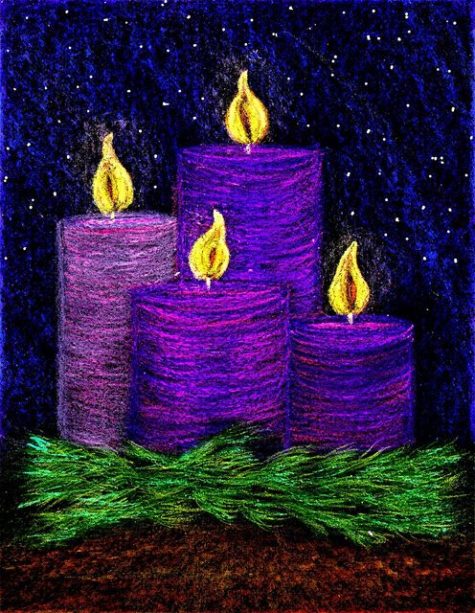 Four Sundays and Four Candles:
Four Sundays and Four Candles:
The keeping of an advent wreath is also a common practice in homes or churches. The readings for the first Sunday in Advent relate to the old testament patriarchs who were Christ’s ancestors, so some call the first advent candle that of hope.
The readings for the second Sunday concern Christ’s birth in a manger and other prophecies, so the candle may be called of Bethlehem, the way or of the prophets.
The third Sunday, Gaudete Sunday after the first word of the introit (Philippians 4:4), is celebrated with rose-colored vestments similar to Laetare Sunday at the middle point of Lent. The readings relate to St. John the Baptist, and the rose candle may be called of joy or of the shepherds.
In the Episcopal Church USA, the collect stir up may be read during this week, although before the 1979 revision of the Book of Common Prayer it was sometimes read in the first Sunday of Advent. Even earlier, ‘Stir-up Sunday’ was once jocularly associated with the stirring of the Christmas mincement, begun before Advent. The phrase ‘Stir up’ occurs at the start of the collect for the last Sunday before Advent in the 1662 Book of Common Prayer.
The readings for the fourth Sunday relate to the annunciation of Christ’s birth, so the candle may be known as the Angel’s candle. The Magnificat or Song of Mary may be featured.
Where an advent wreath includes a fifth candle, it is known as the Christ candle and lit during the Christmas Eve service.
Source: Wikipedia
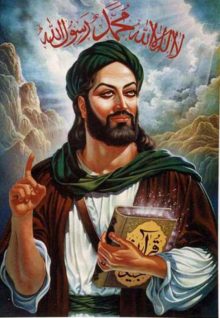 Mawlid (Arabic: مَولِد النَّبِي , “Birth of the Prophet”) is the observance of the birthday of the Islamic prophet Muhammad which is celebrated often on the 12th day of Rabi’ al-awwal, the third month in the Islamic calendar. The 12th Day of Rabi’ al-awwall is the most popular date from a list of many dates that are reported as the birth date.
Mawlid (Arabic: مَولِد النَّبِي , “Birth of the Prophet”) is the observance of the birthday of the Islamic prophet Muhammad which is celebrated often on the 12th day of Rabi’ al-awwal, the third month in the Islamic calendar. The 12th Day of Rabi’ al-awwall is the most popular date from a list of many dates that are reported as the birth date.
In some countries, such as Egypt and Sudan, Mawlid is used as a generic term for the celebration of birthdays of local Sufi saints and not only restricted to the observance of the birth of Muhammad. Around 3,000 Mawlid celebrations are held each year. These festivals attract an international audience, with the largest one in Egypt attracting up to three million people honoring Ahmad al-Badawi, a local 13th-century Sufi saint.
Mawlid is recognized as a national holiday in most of the Muslim-majority countries of the world except Saudi Arabia and Qatar.
Along with being referred to as the celebration of the birth of Muhammad, the term Mawlid also refers to the ‘text especially composed for and recited at Muhammad’s nativity celebration’ or “a text recited or sung on that day”.
The date of Muhammad’s birth is a matter of contention since the exact date is unknown and is not definitively recorded in the Islamic traditions. Among the most recognizable dates, Sunni Muslims believe the date to have been on the twelfth of Rabi’ al-awwal, whereas Shi’a Muslims believe the date to have been on the seventeenth.
Among Muslim scholars, the legality of Mawlid “has been the subject of intense debate” and has been described as “perhaps one of the most polemical discussions in Islamic law”. Traditionally, most Sunni and nearly all of the Shia scholars have approved of the celebration of Mawlid, while Wahhabi and Ahmadiyya scholars oppose the celebration.
Examples of historic Sunni scholars who permitted the Mawlid include the Shafi’i scholar Al-Suyuti (d 911 A.H.) who stated that:
My answer is that the legal status of the observance of the Mawlid – as long as it just consists of a meeting together by the people, a recitation of apposite parts of the Qur’an, the recounting of transmitted accounts of the beginning of (the biography of) the Prophet – may God bless him and grant him peace – and the wonders that took place during his birth, all of which is then followed by a banquet that is served to them and from which they eat – is a good innovation (bid’a hasana), for which one is rewarded because of the esteem shown for the position of the Prophet – may God bless him and grant him peace – that is implicit in it, and because of the expression of joy and happiness on his – may God bless him and grant him peace – noble birth.
The Shafi’i scholar Ibn Hajar al-Asqalani (d 852 A.H.) too approved of the Mawlid and states that:
As for what is performed on the day of the Mawlid, one should limit oneself to what expresses thanks to God, such as the things that have already been mentioned: [Qur’anic] recitation, serving food, alms-giving, and recitation of praise [poems] about the Prophet – may God bless him and grant him peace – and asceticism which motivate people to perform good deeds and act in view of the next world.
Mawlid is celebrated in almost all Islamic countries, and in other countries that have a significant Muslim population, such as India, the United Kingdom, Nepal, Sri Lanka, France, Germany, Italy, Russia and Canada. The only exceptions are Qatar and Saudi Arabia where it is not an official public holiday and is forbidden.
Often organized in some countries by the Sufi orders, Mawlid is celebrated in a carnival manner, large street processions are held and homes or mosques are decorated. Charity and food is distributed, and stories about the life of Muhammad are narrated with recitation of poetry by children. Scholars and poets celebrate by reciting Qaṣīda al-Burda Sharif, the famous poem by 13th-century Arabic Sufi Busiri.
A general Mawlid appears as “a chaotic, incoherent spectacle, where numerous events happen simultaneously,all held together only by the common festive time and space”. These celebrations are often considered an expression of the Sufi concept of the pre-existence of Muhammad . However,the main significance of these festivities is expression of love for Muhammad.
During Pakistan’s Mawlid the day starts with a 31-gun salute in federal capital and a 21-gun salute at the provincial capitals and religious hymns are sung during the day.
In many parts of Indonesia, the celebration of the Mawlid al-nabi “seems to surpass in importance, liveliness, and splendour” the two official Islamic holidays of Eid ul-Fitr and Eid al-Adha.
In Qayrawan, Tunisia, Muslims sing and chant hymns of praise to Muhammad, welcoming him in honor of his birth.Also, generally in Tunisia, people usually prepare Assidat Zgougou to celebrate the Mawlid.
Assidat Zgougou is a Tunisian dessert originally made out of honey, smen and semolina, that dish is now known as “εasida turki”
The lower layer is made of the grains of Aleppo pines “zgougou.” The grains are cleaned, then they are ground in water and sieved to very small sizes. The resulting juicy substance is then mixed with wheat flour and/or starch depending on the recipe. Sometimes concentrated milk is added. Then everything is cooked at low heat while stirred. Powdered sugar is added gradually as the mixture thickens, giving rise to a grayish-brown color.
The result is poured hot in a bowl and cover in a white cream made out of milk, starch, sugar, eggs and a bit of orange blossom essence then decorated with almonds and other seeds and nuts, whole or ground, and small candy.
It is also possible to make an assida out of other nuts instead of the allepo pine’s grains, like hazelnuts, chestnuts, pistachio or others, but in that case it won’t be assidat zgougou, but assidat of what was used.
Among non-Muslim countries, India is noted for its Mawlid festivities. The relics of Muhammad are displayed after the morning prayers in the Indian state of Jammu and Kashmir at the Hazratbal Shrine, where night-long prayers are also held.
Most Shia scholars believe the 17th day of Rabi’ al-awwal is the birthday of the Muhammad, and most Sunni scholars believe that is the 12th day of Rabi’ al-awwal. This issue led to assigning these days (12-17 Rabi’ al-awwal) as Unity Week by Islamic Republic of Iran to respect both viewpoints. So scholars and followers of these two sects emphasize on common ground against the common enemies, and an International Islamic Unity Conference is hosted each year.
Source: Wikipedia
Related Content:
The Kattenstoet, Festival of the Cats, is a parade in Ypres, Belgium, devoted to the cat. It is held every third year on the second Sunday of May. Most recently, the 44th edition took place on May 10, 2015, with the 45th expecting to take place on May 13, 2018.
The parade commemorates an Ypres tradition from the Middle Ages in which cats were thrown from the belfry tower of the Cloth Hall to the town square below. Symbolically reviving this practice for the parade festivities, a jester tosses plush cats from the Cloth Hall belfry down to the crowd, which awaits with outstretched arms to catch one. The throwing of the cats from the belfry is followed by a mock witch burning.
Participants in the festivities often dress as cats, witches, or townspeople from ages past.
There are various legends about how the throwing of cats originated. One possibility is that cats were connected to witchcraft, and the throwing of the cats symbolized the killing of evil spirits.
Another story suggests that the cats were brought in to the Cloth Hall (Lakenhall) to control vermin. Before modern heating and storage methods, when it got cold the wool was stored in the upper floors of the Cloth Hall. At the start of the spring warm-up after the wool had been sold the cats were tossed out of the belfry.
Source: wikipedia
